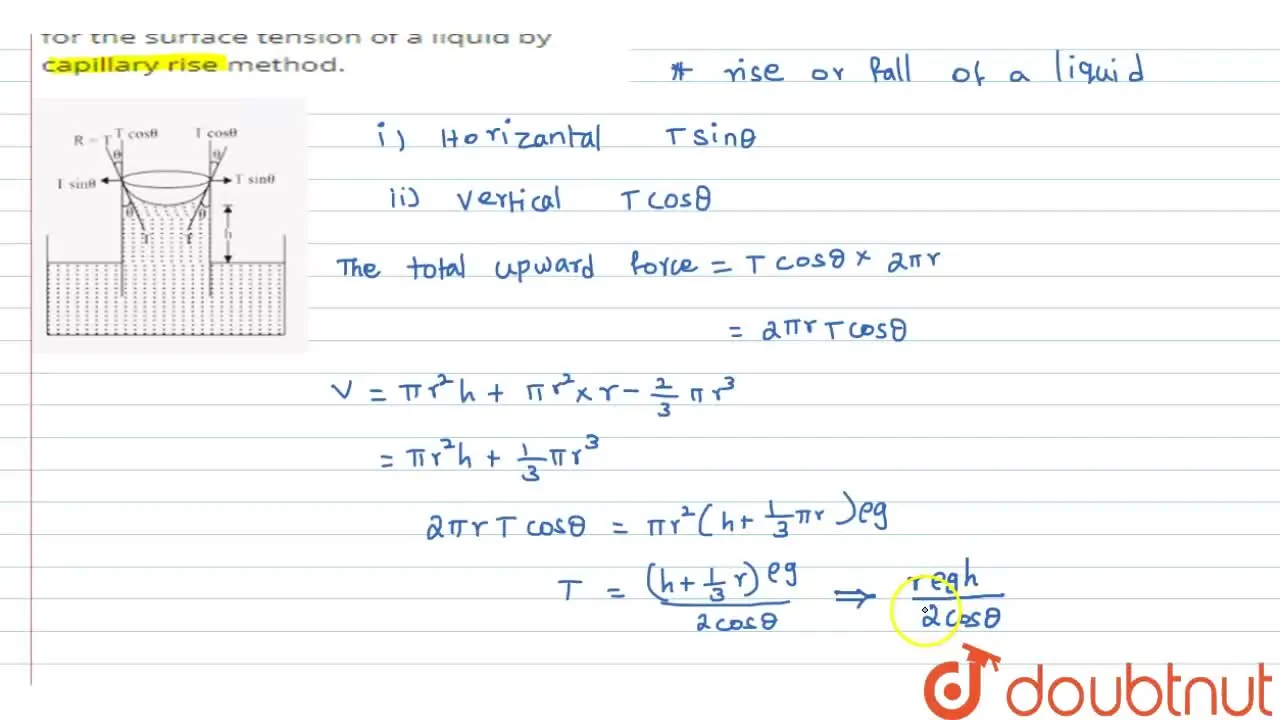What is capillarity? Obtain an expression for the surface tension of a liquid by capillary rise method.Solution in Tamil
In a liquid whose angle of contact with solid is less than , suffers capillary rise. On the other hand, in a liquid whose angle of contact is greater than , suffers capillary fall. The rise or fall of a liquid in a narrow tube is called capillarity or capillary action.
Practical application of capillarity
(i) Due to capillary action, oil rises in the cotton within an earthen lamp. Likewise, sap raises from the roots of a plant to its leaves and branches.
(ii) absorption of ink by a blotting paper.
(iii) Capillary action is also essential for the tear fluid from the eye to drain constantly.
(iv) Cotton dresses are preferred in summer because cotton dresses have fine pores which act as capillaries for sweat.
Surface Tension by capillary rise method: The pressure difference across a curved liquid air interface is the basic factor behind the rising up of water in a narrow tube (influence of gravity is ignored). The capillary rise is more dominant in the case of very fine tubes. But this phenomenon is the outcome of the force of surface tension. In order to arrive a relation between the capillary rise (h) and surface tension (T), consider a capillary tube which is held vertically in a beaker containing water, the water rises in the capillary tube to a height h due to surface tension.
The surface tension force acts along the tangent at the point of contact downwards and its reaction force upwards. Surface tension T, it resolved into two components (1) Horizontal component T sin and (ii) Vertical component T cos acting upwards, all along the whole circumference of the meniscus
Total upward force
where is the angle of contact, r is the radius of the tube. Let be the density of water and h be the height to which the liquid rises inside the tube. Then,
(The volume of liquid column in the tube ) = ( Volume of the liquid column of radius r height h ) + ( volume of liquid of radius r and height h - volume of the hemisphere of radius )
The upward force supports the weight of the liquid column above the free surface, therefore,
If the capillary is a very fine tube of radius (i.e., radius is very small) then - can be neglected when it is compared to the height h. Therefore,
Liquid rises through a height h
This implies that the capillary rise (h) is inversely proportional to the radius (r) of the tube, i.e., the smaller the radius of the tube greater will be the capillarity.

Related Playlists
Similar Questions
Write the difference between C and H.
01:45View SolutionWhat are the applications of dimensional analysis? Verify s=ut+12at2 by dimensional analysis
02:24View SolutionAt the highest point of oblique projection, which of the following is correct?
01:57View SolutionIt is said that a liquid rises or is depressed in a capillary due to the surface tension. If a liquid neither rises nor depresses in a capillary, can we conclude that the surface tension of the liquid is zero ?
02:12View SolutionBy the method of dimensions, obtain an expression for the surface tension S of a liquidk rising in a capillary tube. Assume that S depends on mass m of liquied, Pressure p of liquid and radius r of the capillary tube. Take K=1/2.
04:48View SolutionIf a liquid used in capillary rise method for measuring surface tension whose surface tension is more than that of water, then rise in capillary tube
10:27View SolutionThe rise of a liquid in a capillary tube depends on
02:07View SolutionObtain an expression for the rise of a liquid in a capillary tube.
10:27View SolutionWhat is capillarity? Obtain an expression for the surface tension of a liquid by capillary rise method.
07:32View SolutionGive the expression for surface tension of a liquid in a capillary tube.
08:57View SolutionWhat is capillarity? Obtain an expression for the surface tension of a liquid by capillary rise method.
10:27View SolutionDefine Capillarity and angle of contact. Derive an expression for the ascent of a liquid in a capillary tube.
10:27View SolutionWhat do you mean by capillarity? Give some daily life examples of capillarity. Also derive an expression for rise of liquid in a capillary tube.
02:26View SolutionWhat is capillarity? Obtain an expression for the surface tension of a liquid by capillary rise method.
02:28View SolutionWhat is capillarity? Obtain an expression for the surface tension of a liquid by capillary rise method.
03:22View Solution


